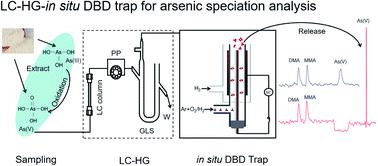当前位置:
X-MOL 学术
›
J. Anal. At. Spectrom.
›
论文详情
Our official English website, www.x-mol.net, welcomes your feedback! (Note: you will need to create a separate account there.)
Sensitivity enhancement of inorganic arsenic analysis by in situ microplasma preconcentration coupled with liquid chromatography atomic fluorescence spectrometry
Journal of Analytical Atomic Spectrometry ( IF 3.4 ) Pub Date : 2020-06-22 , DOI: 10.1039/d0ja00222d Zhenzhen Yao 1, 2, 3, 4, 5 , Meitong Liu 1, 2, 3, 4, 5 , Jixin Liu 1, 2, 3, 4, 5 , Xuefei Mao 1, 2, 3, 4, 5 , Xing Na 5, 6, 7 , Zhihong Ma 7, 8, 9, 10 , Yongzhong Qian 1, 2, 3, 4, 5
Journal of Analytical Atomic Spectrometry ( IF 3.4 ) Pub Date : 2020-06-22 , DOI: 10.1039/d0ja00222d Zhenzhen Yao 1, 2, 3, 4, 5 , Meitong Liu 1, 2, 3, 4, 5 , Jixin Liu 1, 2, 3, 4, 5 , Xuefei Mao 1, 2, 3, 4, 5 , Xing Na 5, 6, 7 , Zhihong Ma 7, 8, 9, 10 , Yongzhong Qian 1, 2, 3, 4, 5
Affiliation

|
In this work, an in situ dielectric barrier discharge trap (DBDT) was first utilized to preconcentrate inorganic arsenic (iAs) species coupled with liquid chromatography hydride generation atomic fluorescence spectrometry (LC-HG-AFS), and a novel LC-HG-in situ DBDT-AFS instrument was thereby fabricated. Considering the relatively deficient sensitivity of LC-HG-AFS and retention of As(V) in a strong anion exchange column, As(V) was chosen as a model species for iAs preconcentration. During the extraction of arsenic species in a rice sample using 1% (v/v) HNO3 and 1% (v/v) H2O2, As(III) was oxidized to As(V) being regarded as iAs. After LC separation, according to the retention time, only As(V) was trapped by 11 kV discharging under 110 mL min−1 air mixed with Ar; following sweeping by Ar gas for 190 s, iAs was released with 13 kV at 180 mL min−1 H2-rich Ar to the AFS for measurement. Via preconcentration, the limit of detection (LOD) of iAs reached 0.05 μg L−1 with ∼10 times enhancement in analytical sensitivity; the linearity (r) was > 0.997 ranging from 0.5 μg L−1 to 50 μg L−1 with 1.9% RSD (5 μg L−1, n = 6). The measured iAs in certified reference materials (CRMs) were all within their certified values, and the spike recoveries were in the range of 93–102%. With sensitivity, robustness, low power, small size and easy operation, the combination of LC and DBDT fulfilled the analysis of trace iAs in rice samples. In fact, other arsenic species can also be preconcentrated and detected to enhance the sensitivity by this proposed LC-HG-in situ DBDT technique via precisely synchronizing DBD trap and release with chromatographic retention. To focus on the food safety, iAs was chosen as a model arsenic species to verify the availability of in situ DBDT. Considering the versatility of DBD, in situ DBDT demonstrates a promising application for elemental speciation analysis and LC atomic spectrometry.
中文翻译:

原位微等离子体预浓缩-液相色谱-原子荧光光谱法提高无机砷分析的灵敏度
在这项工作中,首先使用原位电介质势垒放电阱(DBDT)结合液相色谱氢化物发生原子荧光光谱法(LC-HG-AFS)来预浓缩无机砷(iAs)物种,以及新型LC-HG- in由此制得原位DBDT-AFS仪器。考虑到LC-HG-AFS的灵敏度相对较低以及As(V)在强阴离子交换柱中的保留,选择As(V)作为iAs预浓缩的模型物种。在使用1%(v / v)HNO 3和1%(v / v)H 2 O 2的大米样品中提取砷物种的过程中,As(III)被氧化为As(V)被视为iA。LC分离后,根据保留时间,通过在110mL min -1的空气中混入Ar,通过11 kV放电仅捕集As(V)。在用Ar气体吹扫190 s之后,以13 kV在180 mL min -1 H 2富集的Ar释放iAs到AFS进行测量。通过预浓缩,iAs的检出限(LOD)达到0.05μgL -1,分析灵敏度提高了约10倍;线性度(r)> 0.997,范围为0.5μgL -1至50μgL -1,RSD为1.9%(5μgL -1,n= 6)。经认证的参考物质(CRM)中测得的iA均在其认证值范围内,加标回收率在93–102%的范围内。LC和DBDT的结合具有灵敏度,鲁棒性,低功耗,小尺寸和易于操作的特点,可完成大米样品中痕量iA的分析。实际上,通过该拟议的LC-HG-原位DBDT技术,还可通过精确同步DBD捕集和释放与色谱保留时间,对其他砷物质进行预浓缩和检测,以提高灵敏度。为了关注食品安全,iAs被选为砷的典范物种,以验证原位DBDT的可用性。考虑到DBD的多功能性,就地 DBDT展示了在元素形态分析和LC原子光谱分析中的有前途的应用。
更新日期:2020-08-10
中文翻译:

原位微等离子体预浓缩-液相色谱-原子荧光光谱法提高无机砷分析的灵敏度
在这项工作中,首先使用原位电介质势垒放电阱(DBDT)结合液相色谱氢化物发生原子荧光光谱法(LC-HG-AFS)来预浓缩无机砷(iAs)物种,以及新型LC-HG- in由此制得原位DBDT-AFS仪器。考虑到LC-HG-AFS的灵敏度相对较低以及As(V)在强阴离子交换柱中的保留,选择As(V)作为iAs预浓缩的模型物种。在使用1%(v / v)HNO 3和1%(v / v)H 2 O 2的大米样品中提取砷物种的过程中,As(III)被氧化为As(V)被视为iA。LC分离后,根据保留时间,通过在110mL min -1的空气中混入Ar,通过11 kV放电仅捕集As(V)。在用Ar气体吹扫190 s之后,以13 kV在180 mL min -1 H 2富集的Ar释放iAs到AFS进行测量。通过预浓缩,iAs的检出限(LOD)达到0.05μgL -1,分析灵敏度提高了约10倍;线性度(r)> 0.997,范围为0.5μgL -1至50μgL -1,RSD为1.9%(5μgL -1,n= 6)。经认证的参考物质(CRM)中测得的iA均在其认证值范围内,加标回收率在93–102%的范围内。LC和DBDT的结合具有灵敏度,鲁棒性,低功耗,小尺寸和易于操作的特点,可完成大米样品中痕量iA的分析。实际上,通过该拟议的LC-HG-原位DBDT技术,还可通过精确同步DBD捕集和释放与色谱保留时间,对其他砷物质进行预浓缩和检测,以提高灵敏度。为了关注食品安全,iAs被选为砷的典范物种,以验证原位DBDT的可用性。考虑到DBD的多功能性,就地 DBDT展示了在元素形态分析和LC原子光谱分析中的有前途的应用。



























 京公网安备 11010802027423号
京公网安备 11010802027423号